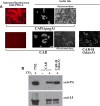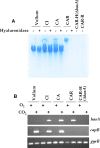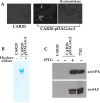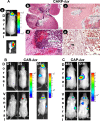Capsules, toxins and AtxA as virulence factors of emerging Bacillus cereus biovar anthracis
- PMID: 25830379
- PMCID: PMC4382292
- DOI: 10.1371/journal.pntd.0003455
Capsules, toxins and AtxA as virulence factors of emerging Bacillus cereus biovar anthracis
Erratum in
-
Correction: Capsules, toxins and AtxA as virulence factors of emerging Bacillus cereus biovar anthracis.PLoS Negl Trop Dis. 2015 Apr 22;9(4):e0003746. doi: 10.1371/journal.pntd.0003746. eCollection 2015 Apr. PLoS Negl Trop Dis. 2015. PMID: 25902046 Free PMC article.
Abstract
Emerging B. cereus strains that cause anthrax-like disease have been isolated in Cameroon (CA strain) and Côte d'Ivoire (CI strain). These strains are unusual, because their genomic characterisation shows that they belong to the B. cereus species, although they harbour two plasmids, pBCXO1 and pBCXO2, that are highly similar to the pXO1 and pXO2 plasmids of B. anthracis that encode the toxins and the polyglutamate capsule respectively. The virulence factors implicated in the pathogenicity of these B. cereus bv anthracis strains remain to be characterised. We tested their virulence by cutaneous and intranasal delivery in mice and guinea pigs; they were as virulent as wild-type B. anthracis. Unlike as described for pXO2-cured B. anthracis, the CA strain cured of the pBCXO2 plasmid was still highly virulent, showing the existence of other virulence factors. Indeed, these strains concomitantly expressed a hyaluronic acid (HA) capsule and the B. anthracis polyglutamate (PDGA) capsule. The HA capsule was encoded by the hasACB operon on pBCXO1, and its expression was regulated by the global transcription regulator AtxA, which controls anthrax toxins and PDGA capsule in B. anthracis. Thus, the HA and PDGA capsules and toxins were co-regulated by AtxA. We explored the respective effect of the virulence factors on colonisation and dissemination of CA within its host by constructing bioluminescent mutants. Expression of the HA capsule by itself led to local multiplication and, during intranasal infection, to local dissemination to the adjacent brain tissue. Co-expression of either toxins or PDGA capsule with HA capsule enabled systemic dissemination, thus providing a clear evolutionary advantage. Protection against infection by B. cereus bv anthracis required the same vaccination formulation as that used against B. anthracis. Thus, these strains, at the frontier between B. anthracis and B. cereus, provide insight into how the monomorphic B. anthracis may have emerged.
Conflict of interest statement
The authors have declared that no competing interests exist.
Figures







Similar articles
-
Toxin and capsule production by Bacillus cereus biovar anthracis influence pathogenicity in macrophages and animal models.PLoS Negl Trop Dis. 2024 Dec 23;18(12):e0012779. doi: 10.1371/journal.pntd.0012779. eCollection 2024 Dec. PLoS Negl Trop Dis. 2024. PMID: 39715264 Free PMC article.
-
Bacillus cereus G9241 makes anthrax toxin and capsule like highly virulent B. anthracis Ames but behaves like attenuated toxigenic nonencapsulated B. anthracis Sterne in rabbits and mice.Infect Immun. 2011 Aug;79(8):3012-9. doi: 10.1128/IAI.00205-11. Epub 2011 May 16. Infect Immun. 2011. PMID: 21576337 Free PMC article.
-
The roles of AtxA orthologs in virulence of anthrax-like Bacillus cereus G9241.Mol Microbiol. 2016 Nov;102(4):545-561. doi: 10.1111/mmi.13478. Epub 2016 Sep 4. Mol Microbiol. 2016. PMID: 27490458 Free PMC article.
-
Bacillus anthracis genetics and virulence gene regulation.Curr Top Microbiol Immunol. 2002;271:143-64. doi: 10.1007/978-3-662-05767-4_7. Curr Top Microbiol Immunol. 2002. PMID: 12224521 Review.
-
What sets Bacillus anthracis apart from other Bacillus species?Annu Rev Microbiol. 2009;63:451-76. doi: 10.1146/annurev.micro.091208.073255. Annu Rev Microbiol. 2009. PMID: 19514852 Review.
Cited by
-
No Assembly Required: Using BTyper3 to Assess the Congruency of a Proposed Taxonomic Framework for the Bacillus cereus Group With Historical Typing Methods.Front Microbiol. 2020 Sep 22;11:580691. doi: 10.3389/fmicb.2020.580691. eCollection 2020. Front Microbiol. 2020. PMID: 33072050 Free PMC article.
-
AtxA-Controlled Small RNAs of Bacillus anthracis Virulence Plasmid pXO1 Regulate Gene Expression in trans.Front Microbiol. 2021 Jan 15;11:610036. doi: 10.3389/fmicb.2020.610036. eCollection 2020. Front Microbiol. 2021. PMID: 33519762 Free PMC article.
-
Toxin and capsule production by Bacillus cereus biovar anthracis influence pathogenicity in macrophages and animal models.PLoS Negl Trop Dis. 2024 Dec 23;18(12):e0012779. doi: 10.1371/journal.pntd.0012779. eCollection 2024 Dec. PLoS Negl Trop Dis. 2024. PMID: 39715264 Free PMC article.
-
Characterization of a Bacillus cereus strain associated with a large feed-related outbreak of severe infection in pigs.J Appl Microbiol. 2022 Aug;133(2):1078-1088. doi: 10.1111/jam.15636. Epub 2022 May 31. J Appl Microbiol. 2022. PMID: 35611609 Free PMC article.
-
Massive horizontal gene transfer, strictly vertical inheritance and ancient duplications differentially shape the evolution of Bacillus cereus enterotoxin operons hbl, cytK and nhe.BMC Evol Biol. 2015 Nov 10;15:246. doi: 10.1186/s12862-015-0529-4. BMC Evol Biol. 2015. PMID: 26555390 Free PMC article.
References
-
- Jensen GB, Hansen BM, Eilenberg J, Mahillon J (2003) The hidden lifestyles of Bacillus cereus and relatives. Environ Microbiol 5: 631–640. - PubMed
Publication types
MeSH terms
Substances
LinkOut - more resources
Full Text Sources
Other Literature Sources
Medical
Molecular Biology Databases

